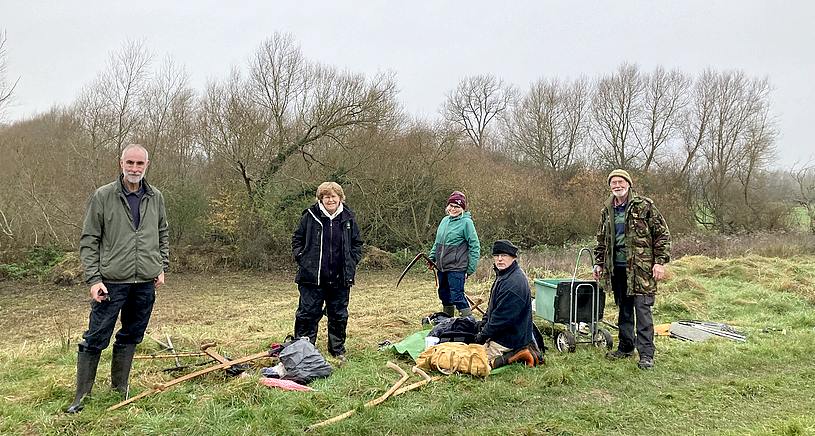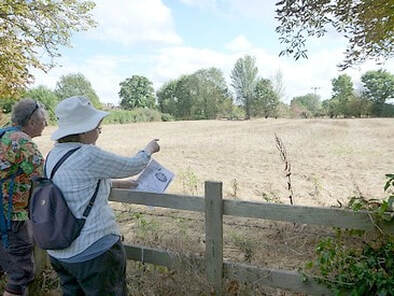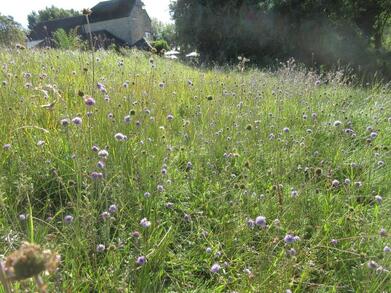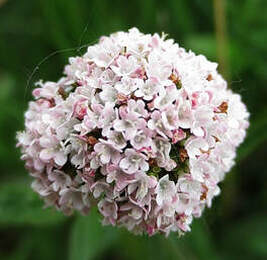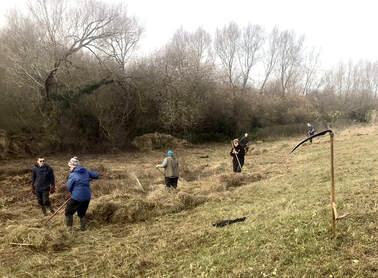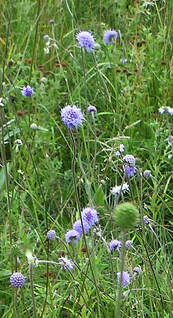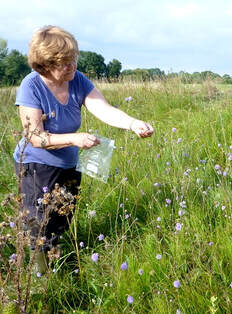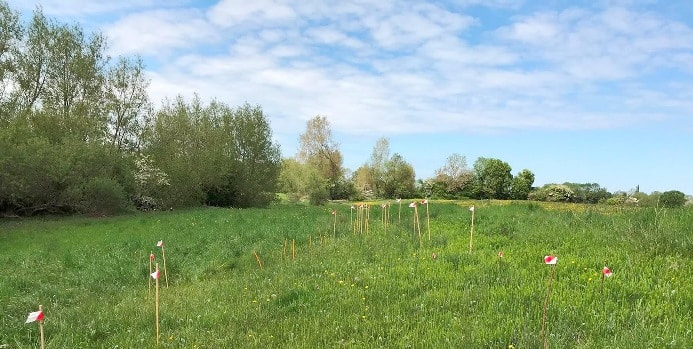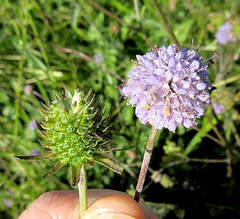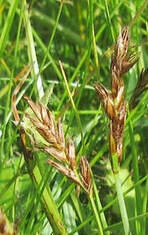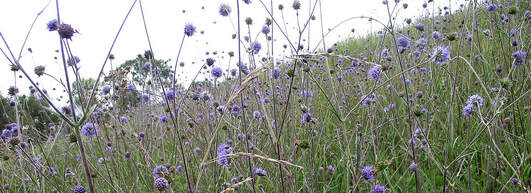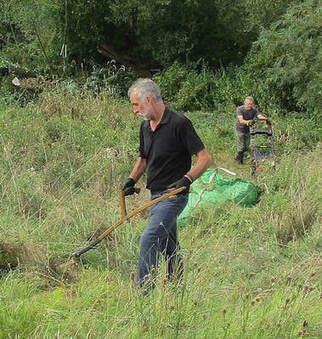Almonds Farm Fields
part of Almonds Farm Fields and Burnt Mill Meadow Local Wildlife Site
Thomas Langdon's 1605 maps of Old Marston Meadows
with Judy's notes on their history (see info pane beside Alan Jones's sketch map - 2nd image) are available here
Photos taken between 2009 and 2014 23 April 2020 Almonds Farm Bank and adjacent meadows 31 Aug 2020
Separate page for Planning matters
26 November 2023 Judy tweeted:
This overgrown seepage bank is home to orchids, marsh valerian, devil's bit scabious and rare flat sedge Blysmus compressus. Without scything and raking off at least once a year all would be lost. Took six of us vols all day to achieve! Also found a devil's bit scabious still in flower and two nests of harvest mice - this site is good for them.
Seepages can be ancient features rich in wetland biodiversity and depend on a water catchment area upslope being protected from soil sealing (like development) or pollution. It's a calcareous seepage bank Local Wildlife Site (LWS) on first terrace above Cherwell floodplain meadows in Marston, Oxford. At junction of gravel terrace with Oxford Clay. Drift aquifer? No Juncus subnodulosus, mostly Carex acutiformis, rare Eleoch. uniglumis. Only native site for Blysmus left in county, source for seed.
Judy's photos are here.
This overgrown seepage bank is home to orchids, marsh valerian, devil's bit scabious and rare flat sedge Blysmus compressus. Without scything and raking off at least once a year all would be lost. Took six of us vols all day to achieve! Also found a devil's bit scabious still in flower and two nests of harvest mice - this site is good for them.
Seepages can be ancient features rich in wetland biodiversity and depend on a water catchment area upslope being protected from soil sealing (like development) or pollution. It's a calcareous seepage bank Local Wildlife Site (LWS) on first terrace above Cherwell floodplain meadows in Marston, Oxford. At junction of gravel terrace with Oxford Clay. Drift aquifer? No Juncus subnodulosus, mostly Carex acutiformis, rare Eleoch. uniglumis. Only native site for Blysmus left in county, source for seed.
Judy's photos are here.
12 March 2023 - Oxford Conservation Volunteers at work on Almond's Farm Bank and in Burnt Mill Meadow
Judy Webb tweeted:'Floodplain of the Cherwell at Oxford in Old Marston doing its thing in Burnt Mill Meadow today. Oxford Conservation Volunteers could not get to the willow planned for coppicing today, but thanks so much to them for trimming back willows to the fence line and scything and raking the wet bank [Almonds Farm bank] where rare Flat Sedge, Marsh Valerian and Marsh Arrowgrass grow. All now short, mimicking the aftermath grazing which no longer operates in this farmland Local Wildlife Site. A rich area also with otter, water vole, harvest mouse,grass snake, frog and probably a great number of invertebrates' Judy's photos are here
2 October 2022: Using some of a grant from the National Lottery Heritage Fund, The Freshwater Habitats Trust funded a visit from Oxford Conservation Volunteers for scything and raking on Almonds Farm bank, and the Burnt Mill Meadow area near the greater water parsnip. The work included collection of devil's-bit scabious seed and spreading it after the raking. Some of the seed will go to help diversity the flora on the burial ground off Elsfied Road, Old Marston, as requested by Councillor Alistair Morris (see item 20 August below). For tweets/photos by the FHT and Judy Webb, click here (for details, see information/caption panel)
Judy Webb tweeted:'Floodplain of the Cherwell at Oxford in Old Marston doing its thing in Burnt Mill Meadow today. Oxford Conservation Volunteers could not get to the willow planned for coppicing today, but thanks so much to them for trimming back willows to the fence line and scything and raking the wet bank [Almonds Farm bank] where rare Flat Sedge, Marsh Valerian and Marsh Arrowgrass grow. All now short, mimicking the aftermath grazing which no longer operates in this farmland Local Wildlife Site. A rich area also with otter, water vole, harvest mouse,grass snake, frog and probably a great number of invertebrates' Judy's photos are here
2 October 2022: Using some of a grant from the National Lottery Heritage Fund, The Freshwater Habitats Trust funded a visit from Oxford Conservation Volunteers for scything and raking on Almonds Farm bank, and the Burnt Mill Meadow area near the greater water parsnip. The work included collection of devil's-bit scabious seed and spreading it after the raking. Some of the seed will go to help diversity the flora on the burial ground off Elsfied Road, Old Marston, as requested by Councillor Alistair Morris (see item 20 August below). For tweets/photos by the FHT and Judy Webb, click here (for details, see information/caption panel)
|
20 August 2022 Oxford City Councillor/Old Marston Parish Councillor Alistair Morris and two other local residents were given a guided walk around Old Marston Meadows by Judy Webb, who explained the history of the meadows and the effects on their ecology that will result from two housing developments for which planning consent has been given. Photos are here. They include a sketch map showing the location of the sites of the two developments: -- Hill View Farm, Planning Application 20/03034/FUL - 159 dwellings -- Land to the West of Mill Lane 21/01217/FUL - 80 dwellings See also Burnt Mill Meadow and related Planning page Information from Sally Gillard, one of the regular volunteers at the site:
'These are ancient meadows, with ridge and furrow showing arable on flat land above the wet bank until around 1640, after the Civil War. Then arable was abandoned, so they have been permanent pasture for the last 300 plus years and are diverse as a result. On the Langdon map of around 1605 this field is called ‘Alesworth Furl Stache’, in its arable phase. The Victoria Arms pub is owned by Oxford Preservation Trust who also own fields to the north of the Almonds Farm one. The pub at one time had all its beer delivered across the Cherwell on the Ferry boat (there was no road from Marston), hence the site is mentioned in old botanical texts as "Marston Ferry" '. On 10 November 2020 The Oxford Mail announced the [lease of] the pub was to be sold by Wadworth Brewery to the Liberation Group (owners of the Butcombe Brewing Company). Devil's Bit Scabious in flower on Almonds Farm wet bank Rear of The Victoria Arms visible in the background |
|
Almonds Farm bank (near the Victoria Arms, seen in photo above) is a limy wet seepage zone - a sort of mini-fen on the slope down to the Cherwell. We need to reduce rank vegetation for the benefit of the rare flowers there, particularly small flat sedge, Blysmus compressus. This inconspicuous plant is nationally red-listed and this site is now the only one in Oxfordshire where it can be found. Also on the site are Marsh Valerian Valeriana dioica (flowers in spring - photo, left, taken by Judy Webb), and Devil's-bit Scabious Succisa pratensiss(flowers late summer - seen in photo below).
Management by volunteers (with permission from Oxford City Council, who own the land) became necessary because of a change in the grazing regime of the tenant farmer from light horse-grazing all year round to very infrequent sheep-grazing, which is insufficient for the flora. The bank cannot be mown for hay like the rest of the field, as it is a bit too steep and wet for machinery. Sheep are not that keen on grazing-down long rank vegetation, so neglect, and development of tall rank sward, would eventually have lost us these and other special flowers on this site. |
|
28 November 2021
More scything and raking on Almond's Farm wet bank. On this occasion Oxford Conservation Volunteers (with hard hats) were also working further along in Burnt Mill Meadow, pollarding a small copse of willows. Photos taken on both sites that day are available here. All taken by Judy Webb, except the one on the left showing her facing the camera, holding a rake, which was taken by David Morris. |
|
11 September 2021 Judy Webb collecting seed of devil's bit scabious, Succisa pratensis, on Almonds Farm wet bank to spread further along the bank where this flower is scarce. The seed cannot spread easily by itself. The plant is in flower from June to October and there are two varieties, one coming into bloom earlier in that period than the other. Their flowing periods do not overlap, so there is no cross-pollination. Those on Almonds Farm bank are the later-flowering variety, particularly useful for pollinators at a time when few plants are in bloom. |
9 June 2021 Photos of common spotted orchids, Dactylorhiza fuchsii, taken by Liz Cooke on 9 June 2021
30 May 2021 David Morris, County Recorder for Oxfordshire, together with Oli Pescott, Botanist and Plant Ecologist at UKCEH, Wallingford carried out monitoring of flat sedge, Blysmus compressus, on Almonds Farm bank. David tweeted: 'Picked a fab day to monitor flat sedge (Blysmus compressus) at its only Oxon site with @sacrevert [Oli Pescott]. Careful counting found 24-500 stems and 24-360 inflorescences per sq metre and something in region of 12,000 plants. Clearly doing well after several years of biannual mowing/raking'. To which Judy Webb replied: 'Some very good news for our Oxon flat sedge native population of this rare sp. on a calcareous seepage bank near the Cherwell within Oxford. All the volunteers that carry out the spring & autumn scything & raking have saved the population from decline when grazing ceased years ago' For more of David's photos, click here.
|
19 September 2020 Judy tweeted: Still peak flowering time for devil's bit scabious in Oxon on Almonds Farm bank LWS wet flush adjacent to Cherwell river. This key species can't spread easily. Seed ready to drop - easy to collect it and move it on along the bank to seed new areas, building up population and providing more insect heaven Devil's bit scabious, Succisa pratensis, photo taken by Judy at Almonds Farm bank |
|
23 July 2020 Judy tweeted:
On this wet calcareous spring/seepage bank next to Cherwell river in Oxford lives the last native Oxon population of rare flat sedge Blysmus compressus (photo by Judy). Horse grazing ceased 10 years ago, since when it has been maintained by volunteers scything and raking the bank spring and autumn. It's not showy, but has subtle charms in my view! Now is the time to try and re-introduce this sedge (named from 'Blusmus' meaning a source or spring where it grows) into historic sites such as Lye Valley fen springs, maintained to the short sward it wants by mowing. See David Morris's blog entry, 23 March 2017, about Blysmus compressus on this site |
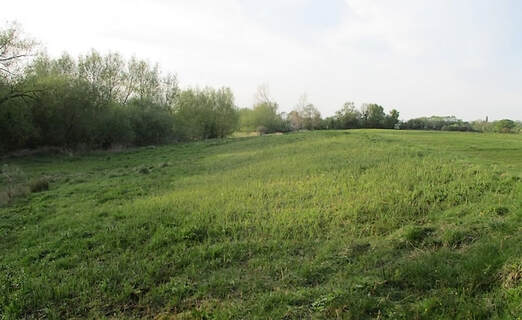
Almonds Farm bank - 23 April 2020
Mowing, scything and raking carried out by volunteers led by Rod D'Ayala on 15 March, in pouring rain, before the spring sward began vigorous growth, kept the vegetation growth in check.
Lesser pond sedge, Carex acutiformis, seen in the foreground, can grow up to 150 cm tall, so one of the aims of that scything and mowing was to reduce its vigour to give smaller plants, such as marsh valerian (photo below) and the rare flat sedge, Blysmus compressus, a ‘vulnerable’ Red Data Book species, which appears later, a better chance of flourishing.
More photos from 23 April 2020, plus two from June and November that year are here
Mowing, scything and raking carried out by volunteers led by Rod D'Ayala on 15 March, in pouring rain, before the spring sward began vigorous growth, kept the vegetation growth in check.
Lesser pond sedge, Carex acutiformis, seen in the foreground, can grow up to 150 cm tall, so one of the aims of that scything and mowing was to reduce its vigour to give smaller plants, such as marsh valerian (photo below) and the rare flat sedge, Blysmus compressus, a ‘vulnerable’ Red Data Book species, which appears later, a better chance of flourishing.
More photos from 23 April 2020, plus two from June and November that year are here
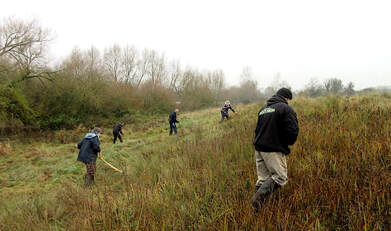
4 November 2019:
Scything and raking on Almonds Farm bank, the last native site in Oxfordshire for the little National Red-listed Flat Sedge Blysmus compressus, which loves the calcareous seepage here.
As Judy explains in her tweet, 'Grazing is now too intermittent to provide the short turf it loves, so we scythe and rake twice a year. Lots of other good plants there including marsh valerian in spring and, even now, last devil's bit scabious flowers. Found 3 harvest mouse nests as well and water vole evidence!
See Judy's tweet on 1 December 2019
Scything and raking on Almonds Farm bank, the last native site in Oxfordshire for the little National Red-listed Flat Sedge Blysmus compressus, which loves the calcareous seepage here.
As Judy explains in her tweet, 'Grazing is now too intermittent to provide the short turf it loves, so we scythe and rake twice a year. Lots of other good plants there including marsh valerian in spring and, even now, last devil's bit scabious flowers. Found 3 harvest mouse nests as well and water vole evidence!
See Judy's tweet on 1 December 2019
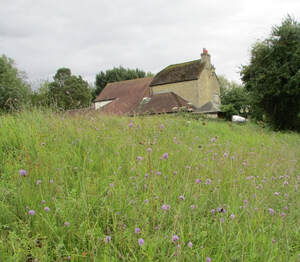
16 September 2018:
Cutting and raking on Almond's Farm Local Wildlife Site wet bank, just north of the Victoria Arms pub, which is owned by Oxford Preservation Trust (seen in the photo). On 10 November 2020 The Oxford Mail announced the [lease of] the pub was to be sold by Wadworth Brewery to the Liberation Group (owners of the Butcombe Brewing Company).
This year the scything/raking took place earlier than last year due to the dry, hot, summer.
The bank has to be cut and the cuttings raked off to preserve the flower biodiversity
Devil's bit scabious, Succisa pratensis, which is very valuable for pollinators, as it flowers late in the year when other plants have gone to seed, is abundant on this bank - seen in photo on the right and below.
16 September 2018:
Cutting and raking on Almond's Farm Local Wildlife Site wet bank, just north of the Victoria Arms pub, which is owned by Oxford Preservation Trust (seen in the photo). On 10 November 2020 The Oxford Mail announced the [lease of] the pub was to be sold by Wadworth Brewery to the Liberation Group (owners of the Butcombe Brewing Company).
This year the scything/raking took place earlier than last year due to the dry, hot, summer.
The bank has to be cut and the cuttings raked off to preserve the flower biodiversity
Devil's bit scabious, Succisa pratensis, which is very valuable for pollinators, as it flowers late in the year when other plants have gone to seed, is abundant on this bank - seen in photo on the right and below.
|
16 September 2018:
This year the scything/raking took place earlier than last year due to the dry, hot, summer. A Painted Lady butterfly was seen on the Devil's-bit scabious flowers. Photo: Richard Queralt, expert scyther, and Rod D'Ayala shortening the grass and plant growth further with the Cobra mower - for more photos, click here (Clicking on 'i' in white circle in slideshow mode displays full caption, where available) |
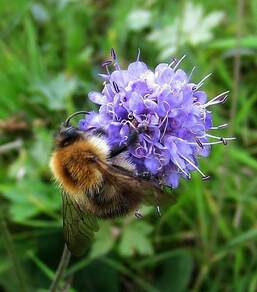 Devil's bit scabious - photo Judy Webb Devil's bit scabious - photo Judy Webb
1 Oct 2017: Cutting and raking on Almond's Farm Local Wildlife Site wet bank (just north of Victoria Arms). During the scything and raking, a caterpillar of the Knot Grass moth, Acronicta rumicis, was spotted eating seeds of Devil's Bit Scabious. For photos, click here (Clicking on 'i' in white circle in slideshow mode displays full caption, where available) |
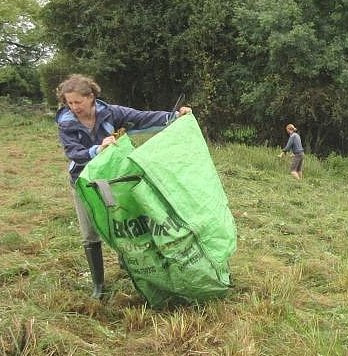
|
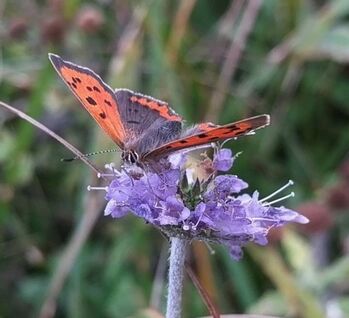
Small Copper butterfly, a declining species (see The Guardian, 22 03 2016)
on Devil's Bit Scabious, Succisa pratensis, (Vascular Plant Red List for England, 'Near Threatened' ) on Almond's Farm wet bank, 27 09 2017
Photo by George Cox
For more photos, click here
In slideshow, click on 'i' in white circle for info.
Small Copper butterfly, a declining species (see The Guardian, 22 03 2016)
on Devil's Bit Scabious, Succisa pratensis, (Vascular Plant Red List for England, 'Near Threatened' ) on Almond's Farm wet bank, 27 09 2017
Photo by George Cox
For more photos, click here
In slideshow, click on 'i' in white circle for info.
Photos taken of Almond's Farm LWS wet bank on 7 September 2017
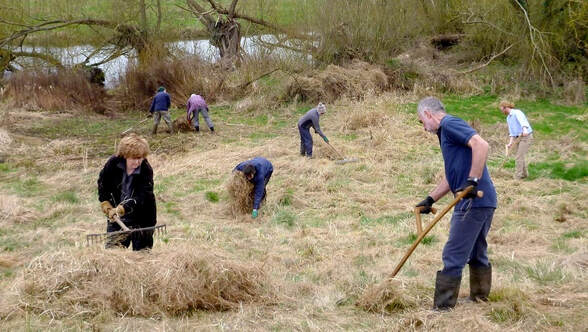
19 March 2017:
Clearing rank overgrowth on a bank with a number of rare and scarce plants on a spring line in Burnt Mill Meadow and Almond's Farm Local Wildlife Site. The bank is in Almond's Farm Meadow, property of Oxford City Council.
Due to tenant farmer changes the bank had not been grazed or cut for 6 years. Rare plants would have beeen lost, if no action had been taken.
For photos of the event click here
For videos, click here
The nationally red-listed Small Flat Sedge, Blysmus compressus is the rarest plant found here; this is its last site in Oxfordshire. David Morris (one of the scythers) is its Flora Guardian within the Oxfordshire Flora Group - see his 23 March 2017 entry at https://oxbot.blogspot.com/2017/03/
Photos of a Drinker Moth and caterpillar taken by Judy Webb and Christopher Hoskin in Almond's Farm Meadow in 2015
